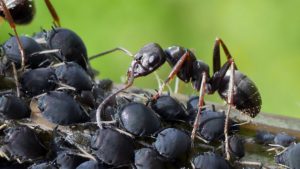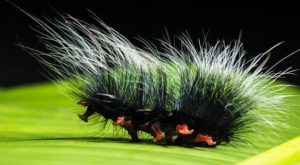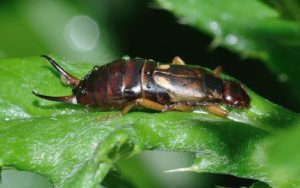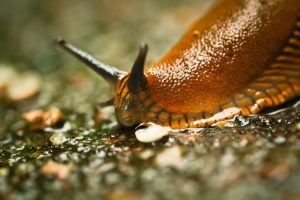Most diseases and pests that affect plants in containers, also commonly affect those that are found in gardens. These problems are often due to improper care, which can be often improved by better cultivation and maintenance of the plants in containers.
Chemical sprays are limited because of the vastly reduced numbers available, due to the number of chemical pesticides and fungicides that have been withdrawn that will tackle diseases and pests.
As consumers, we have become more environmentally friendly, and the effect pesticides have on our native species such as birds, bees, butterflies, and ladybirds are becoming better known. The choice of being organic or inorganic is up to you, but remember everything comes with a price.
You need to check your plants regularly and act quickly if a disease or pest has been identified, in order to minimize the effect it has on other plants close by.
PESTS
Aphids and Ants
Black, white or green fly are the most common pest found on plants. These insects such sap from shoots and stems, causing distortion of the tip leaves and flowers. These bugs can also transfer viruses to the plant, which can have a detrimental effect. When watering or deadheading, check the plant for colonization. When seen remove them with a water spray or wipe off using your fingers.

If really bad pinch off the growing tips. Ants can often be seen along with aphids, and this is a mutually beneficial relationship, as ants often feed on honeydew (the excrement that the aphids produce). The ants farm the aphids and often offer protection in exchange for their poo. Ants themselves cause little damage and so if you get rid of the aphids, you get rid of the ants.
Caterpillars
There are many caterpillars produced by butterflies and moths. Some feed singly and are so well camouflaged that you cannot see them until they have caused extensive damage to the leaves.

On the other hand, others appear in such large numbers that it is difficult to miss the damage they cause. Hand pick all visible ones and dispose of them. Wear thick gloves whilst doing so, as some hairy caterpillars can cause skin irritation. Various inorganic and organic sprays exist that can deal with this problem.
Earwigs
This familiar insect with pincher claws on its head, rarely do any serious damage, but can sometimes cause more damage on chrysanthemums and dahlias flowers. These tiny creatures are nocturnal, as they feed during the night and hide during the day.

You can try trapping them using upturned flower pots filled with straw, suspended by a garden cane. Empty them during the day, but remember they can help with aphid problems.
Leaf Miners
The first signs of an attack are wiggle lines or white blisters in the leaf, which signals the leaf miner problem is here. The leaf miner itself is a tiny grub, which burrows in the veiny part of the leave between the upper and lower surface of the leaves.

Chrysanthemums and argyranthums are badly affected, along with beetroots, Swiss chard, and perpetual spinach. If the problem is not dealt with quickly, by picking off affected leaves, then the whole leaf can die. It is rarely detrimental to the plant itself but can have an effect on beetroot size.
Scale Insects
These pests are often found on evergreen shrubs such as bay, rhododendrons, and camellias. The insect looks like a small brown blister found on the stem and on the underside of leaves near the midrib. Normally black soot of the leaves is the first visible sign of any infestations, along with a honeydew residue.

Scale insects may also transfer viruses to the plant and so must be dealt with quickly in order to prevent any losses. Sprays rarely work due to the armour plating shell that prevents chemical penetration. Small colonies can be controlled by wiping the leaves with methylated spirit soaked cotton wool balls. Honeydew and black soot can be simply wiped off using a cloth soaked with water. If the infestation is really bad, you will seriously need to think about disposing of the plant and get a new one.
Slugs and Snails
These familiar pests can devastate plants by eating leaves, stems, and flowers. Tell-tale signs are a silvery slime trail to the plant in the container. These slimy creatures are often brought into the container by the purchasing of a new plant where clusters of slug eggs are present, normally hidden at the bottom of the flower pot. Often baby slugs are present, so check plants before purchasing them.

Slugs and snails are nocturnal, so they can be caught under torchlight at night. Beer traps are very effective, as long as you use cheap beer. Mulch, coffee granules and sharp gravel can also be used to deter slugs and snails. Copper tape around containers can be used as well but I have not found them to be very effective.
Vine Weevils and Beetles
These members of the beetle family are recognized by their elongated faces. The beetles are slow moving and usually feed at night. They love evergreen shrubs such as euonymus and rhododendrons, leaving u-shaped bites at leaf edges.

Once adults are seen dispose of immediately as they can lay hundreds of eggs in the compost. The grubs that emerge from the eggs can cause severe damage as they eat the root of plants, causing a sudden collapse of the plants.

Pots ferns, ivies, heucheras, polyanthus and strawberry in a container can also be severely affected by the grub. Lily beetles can often attack lily plants and must be dealt with quickly, as the grubs can be devastating, stripping leaves of plants and flowers within a few days. The brightly colour red beetle need to be handpicked off and then crushed underfoot to prevent them from returning to the plant.
Woodlice
The armoured plated pests literally eat at night and hide during the day, normally at the base of pots or trays. Their diets are usually dead material, but seedling may be eaten at the base of the plant. The evidence is circumstantial as it has never been proven that the damage they cause is actually caused by woodlice.

Physical control is impossible, but if you keep debris to a minimum then some control is guaranteed. Very bad infestations can be controlled by the use of ant powder and it can be used around seedlings to protect them.
DISEASES
Grey Mould or Botrytis
This is when grey mould forms on decaying matters. This is more problematic in autumn and winter when growth starts to slow down and fungi will attack the plant when it is at its weakest.

To prevent the disease you need to remove all dead and decaying material including debris, spent flowers and yellowing leaves. Winter flowering pansies, violas, primroses and polyanthus are severely affected.
Leaf Spot
This is a fungal infection that causes the leaf to discolour and have spots on them. Overwatering of plants can cause this, with leaves turning yellow and with noticeable blotches on them.

Lower leaves tend to be particularly affected by the condition. The usual remedy is to reduce watering until the plant recovers if it does at all.
Mildew
The most common fungal infection that affects container plants is powdery mildew and not the uncommon down mildew. It normal affects leaves where a noticeable white coating is observed. In hot, dry summers the disease because prevalent, especially if the plants has not been watered enough.

The best prevention is to make sure that the plant never dries at the roots. Some people swear by a spray made out of skimmed milk mixed with water in the ratio of 1 part milk to 10 parts water. Courgettes growing outside in containers tend to be severely affected.
CONCLUSIONS
In this article common pests and diseases that affect container growing plants have been discussed. It is not comprehensive as other pests and diseases exist but the most common ones are discussed.
If you have any comments, questions or general observations, I will be pleased to answer them if you leave a comment below.
Thanks.


Very informative. My most annoying pest are snails and slugs. I did not have any luck with the copper either due to the fact that they would just climb the wall near the plant and get in that way. I would crush egg shells to layer the dirt which worked well until a hard rain would wash them away. I will try the beer trap that you mention. I had not heard of that one. Thanks for the info!
Hi Katie
Beer traps are very effective against slugs and snails as they really love beer. All you need to do is place a saucer of cheap beer near your precious plants and at night they will travel to the saucer and drown in beer. A good way to go.
Thanks for your comment
Antonio
Very good information. I don’t really garden but my mother and mother-in-law does, so I will have to share with them.Thank you sharing.
Hi Marvin
It is never too late to learn gardening, as the health benefit has been demonstrated by the medical field. Give my regards to your mother and mother-in-law and tell to t come back with my future ideas for articles.
Thanks for the comment
Antonio
I always get annoyed and feel my time wasted when I see articles that give little advice. My mind still wants to understand the reason why and how things work before I can take any information. As a young girl, I lived in a town, and we had always problems with pests. I hate them. 🙂 I like how you explain what to do if there are pests and diseases.
Your article had value in every sentence for me, and I am grateful. Thank you.
Hi Tina
Thanks for the warm words. The battle between people and pests and diseases is a constant one, which can never be truly won. It can be controlled with the tips raised in this article.
Thank You
Antonio